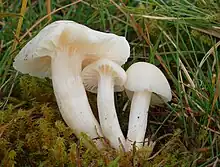Cuphophyllus virgineus
Cuphophyllus virgineus is a species of agaric (gilled mushroom) in the family Hygrophoraceae. Its recommended English common name is snowy waxcap in the UK.[1] The species has a largely north temperate distribution, occurring in grassland in Europe and in woodland in North America and northern Asia, but is also known from Australia. It typically produces basidiocarps (fruit bodies) in the autumn.
| Cuphophyllus virgineus | |
|---|---|
 | |
| Scientific classification | |
| Domain: | Eukaryota |
| Kingdom: | Fungi |
| Division: | Basidiomycota |
| Class: | Agaricomycetes |
| Order: | Agaricales |
| Family: | Hygrophoraceae |
| Genus: | Cuphophyllus |
| Species: | C. virgineus |
| Binomial name | |
| Cuphophyllus virgineus (Wulfen) Kovalenko (1989) | |
| Synonyms | |
| |
Taxonomy
The species was first described in 1781 by the Austrian mycologist Franz Xaver von Wulfen as Agaricus virgineus. It was subsequently combined in a number of different genera, being transferred to Hygrocybe in 1969 before being transferred to Cuphophyllus. The specific epithet comes from Latin "virgineus" (= pure white).[2] Hygrocybe nivea, first described by the Italian mycologist and naturalist Giovanni Antonio Scopoli in 1772, was sometimes distinguished by producing smaller and more slender fruit bodies than H. virginea, but is now regarded as a synonym.[3]
Molecular research published in 2011, based on cladistic analysis of DNA sequences found that Hygrocybe virginea does not belong in Hygrocybe sensu stricto and belongs in the genus Cuphophyllus instead.[4]
Description
Basidiocarps are agaricoid, up to 75 mm (3 in) tall, the cap convex at first, becoming flat or slightly depressed when expanded, up to 75 mm (3 in) across. The cap surface is smooth, waxy when damp, hygrophanous and somewhat translucent with a striate margin, white to ivory (rarely with ochre to brownish tints). The lamellae (gills) are waxy, cap-coloured, and decurrent (widely attached to and running down the stipe). The stipe (stem) is smooth, cylindrical or tapering to the base, cap-coloured, and waxy when damp. The spore print is white, the spores (under a microscope) smooth, inamyloid, ellipsoid, about 7.0 to 8.5 by 4.5 to 5.0 μm.[3] The taste is bitter to acrid.[5]
The species is sometimes parasitized by the mould Marquandomyces marquandi, which colours the lamellae violet.[3]
Similar species
Cuphophyllus russocoriaceus is very similar in appearance, but can be distinguished in the field by its strong smell of sandalwood. Cuphophyllus berkeleyi is also similar, but fruit bodies are typically larger and non-hygrophanous (it has sometimes been considered a white form of Cuphophyllus pratensis).[3]
Distribution and habitat
The snowy waxcap is widespread throughout the north temperate zone, occurring in Europe, North America, and northern Asia, and has also been recorded from Australia.[6] Like other waxcaps, it grows in old, unimproved, short-sward grassland (pastures and lawns) in Europe, but in woodland elsewhere. Recent research suggests waxcaps are neither mycorrhizal nor saprotrophic but may be associated with mosses.[7]
Conservation
In Europe, Cuphophyllus virgineus is typical of waxcap grasslands, a declining habitat due to changing agricultural practices. Cuphophyllus virgineus is one of the commonest species in the genus and is not considered to be of conservation concern (unlike most other waxcaps).[3] In 1997, the species was featured on a postage stamp issued by the Faeroe Islands.
Edibility
Fruit bodies are considered edible and good.[8]
References
- Holden L. (April 2022). "English names for fungi 2022". British Mycological Society. Retrieved 2022-12-06.
- Rea C. (1922). British Basidiomycetaceae: A Handbook of the Larger British Fungi. Cambridge, UK: Cambridge University Press. p. 799.
- Boertmann D. (2010). The genus Hygrocybe (2nd ed.). Copenhagen: Danish Mycological Society. p. 200. ISBN 978-87-983581-7-6.
- Babos M, Halász K, Zagyva T, Zöld-Balogh Á, Szegő D, Bratek Z (2011). "Preliminary notes on dual relevance of ITS sequences and pigments in Hygrocybe taxonomy". Persoonia. 26: 99–107. doi:10.3767/003158511X578349. PMC 3160800. PMID 22025807.
- Trudell, Steve; Ammirati, Joe (2009). Mushrooms of the Pacific Northwest. Timber Press Field Guides. Portland, OR: Timber Press. p. 66. ISBN 978-0-88192-935-5.
- "Hygrocybe virginea". GBIF. Retrieved 2011-12-28.
- Seitzman BH, Ouimette A, Mixon RL, Hobbie EA, Hibbett DS (2011). "Conservation of biotrophy in Hygrophoraceae inferred from combined stable isotope and phylogenetic analyses". Mycologia. 103 (2): 280–290. doi:10.3852/10-195. PMID 21139028. S2CID 318326.
- Phillips, Roger (2010) [2005]. Mushrooms and Other Fungi of North America. Buffalo, NY: Firefly Books. p. 76. ISBN 978-1-55407-651-2.